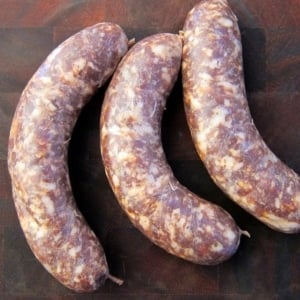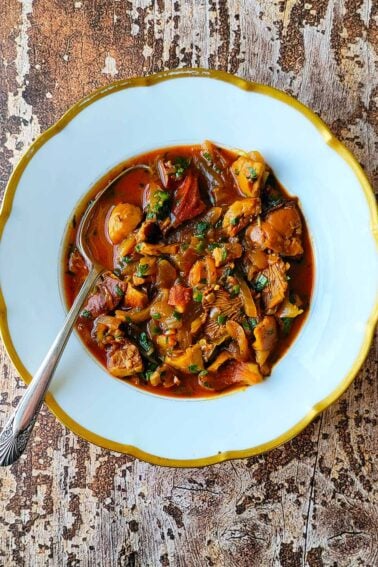As an Amazon Associate I earn from qualifying purchases.
Typical bratwurst recipes make a light colored sausage, like the classic Sheboygan bratwurst recipe I make with pork or turkey. But for venison bratwurst, I want a darker, smokier link. That means red brats.

What is a red brat? It’s apparently unique to Madison, Wisconsin.
I am a proud graduate of the University of Wisconsin, and I spent many an evening drinking beer, watching the Badgers and eating these red brats from State Street Brats in Madison. Red brats are smoky and addicting. Learn to make this recipe and you’ll find yourself rooting for my Badgers, at least a little…
State Street Brats does theirs with beef, but this is venison bratwurst, albeit cut with pork for beef fat. In this case, you choose. I typically go for lean venison and pork belly or fatty shoulder, but beef fat trimmed from roasts or steaks is also a good choice here.
Red brats are always smoked. I prefer to smoke these over oak or fruit woods, with cherry being my favorite, but you can smoke your bratwurst over any wood that makes you happy.
That said, I won’t come to your house and beat you up if you don’t smoke your venison bratwurst, so you do you. I have in fact skipped the smoking step and just grilled them, or poached them in beer with sauerkraut and onions.
The seasoning is pretty classic bratwurst: garlic, black pepper, mustard seeds, a little sage, a little mace or nutmeg. And where a Sheboygan bratwurst uses cream for the liquid, here you use beer. Lager is my choice, and a macro brew like Miller is fine here, although I prefer to use Stevens Point when I can get it.
Venison bratwurst should be grilled or poached in beer as I mentioned above, served with mustard on a bun or not, with sauerkraut. I like using my fennel sauerkraut. If you hate sauerkraut, caramelize some onions instead.
The sausages will keep in the fridge for a week or so, and freeze very well. One question I get asked a lot is whether you can thaw frozen venison, make these brats, then refreeze. If you smoke them or otherwise cook them through, the answer is yes. Just remember that they will be heat-and-eat when you thaw them again.
Looking for other venison sausages? Try my venison garlic sausage, or my smoked Cajun andouille sausage, or my Greek loukaniko sausage.
New to making sausage? You can find my detailed tutorial on how to make sausages at home here.
Venison Bratwurst
Ingredients
- 3 pounds venison
- 2 pounds very fatty pork shoulder or pork belly
- 34 grams kosher salt
- 4 grams Instacure No. 1
- 1 tablespoon sugar
- 25 grams powdered milk
- 3 tablespoons minced garlic
- 1 tablespoon freshly ground black pepper
- 2 teaspoons coarsely ground mustard seed
- 1 ½ teaspoons ground mace or nutmeg
- 1 ½ teaspoons dried sage
- 1/2 cup cold lager beer
- Hog casings
Instructions
- Get out about 10 to 15 feet of hog casings and soak them in warm water. If you don’t trust your source, run water through them to check for punctures or weak spots.
- Cut the venison and pork into chunks that will fit into your grinder. Mix with the salt, sugar, and curing salt (Instacure No. 1) and refrigerate overnight. Doing this helps the sausage bind to itself later. You can skip the overnight rest, but your sausage will not be as firm in the casing.
- When you are ready to make the sausage, freeze your grinder’s grinding plate and blades, and the bowl you will put the meat into for 30 minutes to an hour. Do the same for the meat and fat. When everything’s nice and cold—no warmer than 38°F — mix the meat and fat with the powdered milk and all the spices.
- Grind it all through a coarse plate; I use a 7 mm plate. Test the temperature of the mixture, and if it’s 35°F or colder, go ahead and grind half the mixture again through a fine die, like a 4.5 mm or some such. Set it back with the rest of the ground meat mixture. If it’s warmer than 35°F, put the mix back in the freezer to chill. This might take an hour or so if you’ve let the meat warm up too much. Use the time to clean up.
- Once the sausage has been ground twice, test the temperature again to make sure it’s 35°F or colder. I prefer to chill the mix down to 28°F to 32°F for this next stage. Chill the mix and when it’s cold enough, take it out and add the beer. Now, mix and knead this all up in a big bin or bowl with your (very clean) hands for a solid 2 minutes — your hands will ache with cold, which is good. You want everything to almost emulsify.
- Stuff the sausage into hog casings rather loosely. Do this in a coil before you make the links. I like this sausage in links of about 6 to 8 inches long, but it’s your choice. To twist them into individual sausages, tie off one end of the coil you just made. Pinch off links with your two hands and roll the link between them forward a few times. Move down the coil and repeat, only this time roll backwards a few times. Repeat until you do the whole coil. (This video shows how I do it.)
- Now look at the links, which will probably have air pockets in them. Use a sterile needle or sausage pricker (set it aglow in your stovetop flame) to puncture the casing over all the air pockets. Gently compress the links together to squeeze out the air pockets and rotate the links a bit more to tighten; this takes practice.
- Dry your links in a cool place for at least 24 hours and up to 3 days. I hang mine in a curing fridge set to 55°F, with about 75 percent humidity. The curing salt will protect them during this time. If you haven’t used curing salt, dry the sausage uncovered in the fridge for a day.
- To smoke the links, hang in a cool smoker and let the heat come up slowly until it hits about 200°F. Smoke the links until their internal temperature hits 150°F. This may be less than 3 hours, but internal temperature is more important. As soon as the sausages are cooked, submerge them in an ice water bath until cool. Pat dry and store in the fridge.
Notes
Keys to Success
- You kinda want these to be fatty, so don't skimp on it. 25 percent fat by weight at least, and I prefer closer to 35 percent with this recipe.
- You can play around with the spices, but not the salt. The salt and curing salt are there for food safety.
- The powdered milk is there to absorb moisture, which prevents shrinkage when the sausages come out of the smoker.
Nutrition
Nutrition information is automatically calculated, so should only be used as an approximation.






hi recipe look good but I was wondering if there is any substitute for the lager that you recommend my wife like brats too but doesnt really like the beer flavor she some how always notices it. thank you
Devan: Sure, use ice water.
Hmm. Conundrum. I have about 8lbs of venison thawing and I’m just realizing that this recipe calls for smoking at the end. I was planning on making it and freezing it for the upcoming months as I usually do with sausage after I make it and then air it out. How would you suggest I do this? I was considering your sheboygan brats, but that calls for a different meat. I’m torn on skipping the smoking/instacure and just going straight to the freezer after drying… Skipping the smoking/instacure and using smoked salt and freezing… And going ahead with the instacure and a very short, cool-ish smoke and freezing.
This is almost identical to the venison bratwurst my father would make sometimes if he had the meat (Dad’s problem wasn’t coming up with ways to use venison; it was getting enough deer to do everything he wanted to.) The only difference is that Dad would use leaf fat/suet, usually from a doe, instead of pork and the fattiest venison scraps he had.
Looking through this recipe and getting ready to try it.
Question – do you want the hog casings to soak for 24 hours?
Roy: Sorry for the late reply. No, you don’t. Just an hour or so is good.
From my own experience fresh, salted or brined hog casings only need to be rinsed and flushed (water run through the casings), then stored in water until you use them. Any extra flushed and washed casings can be returned to the container they’re from, then stored in the refrigerator or freezer until needed again. Dad usually bought fresh every deer season and discarded any left over from the previous year. Usually the year old casings were in such a weak brine that they had started to rot a bit. Since Dad would buy a bulk package, he had casings on hand for any experimenting he wanted to do during the spring and summer. (Once he shot three woodchucks and made fresh brats out of them in July. They were a bit dry but the ones made from coon legs were just right moisture wise but raccoons are a fattier animal.)
Tried these using pork shoulder, and probably needed a fattier pork. They turned out a little dry. I am tempted to try this recipe again without the curing salt, and without smoking, and create fresh (not cured) brats.
Jeff: If you do that, maybe try my recipe for Sheboygan brats, which are the typical “white brat” in Wisconsin. They are not smoked, and are pure pork.
Hank,
I had a butcher grind my venison for me and add pork fat to an 80/20 ratio. If I were to use this meat for this recipe should I skip the 7mm grind and simply add the seasonings and grind at 4.5 mm once to incorporate?
Thanks,
Nick
Nick: Yes.
Thank you for this. My late Dad never shared any of his venison recipes
Merry Christmas, Hank!
We do a lot of our meats with a cold smoke. Would you change any of the ingredients if done this way?
Jason: Nope, I would not. You are lucky! It’s a a rare thing to be able to cold smoke these days.
Just to clarify does all of the meat get ground through the smaller plate or just half?
Thanks!
Jon: That’s up to you. I like a mix of half and half, coarse + fine, as I think it gives you a better texture. That said, you can stick with all coarse (6 mm die) or all fine if that’s what you prefer.
Hello Hank,
I just completed step 2 and my grinder died on me. my new grinder will not arrive for another 2 days. is there any harm in leaving the meat/fat chunks in the fridge for a few days mixed with the salt, sugar and instacure #1?
Zach: Nope. It will actually improve the bind.
Should I be adding extra pork fat to this or will the pork shoulder be enough? You mention 35% fat and it seems like just using shoulder wouldnt provide that much. Thanks!
Kyle: If that shoulder isn’t fatty, then yes. I will often add a mix of shoulder and belly, or shoulder and fatback.
I am having similar issues—done this recipe twice now (grilled, not smoked—thanks for not beating me up!) and the taste is good but they are a bit dry. The consensus online is that pork shoulder is 20-30% fat (by weight, meaning that this recipe only has 0.lbs of fat right now) so I’m going to add about 1lb of pork fat and run it back.
Derek: You’re right, a good sausage is definitely 20-30% fat. I think I need to be more specific on the KIND of pork shoulder to use. I really use the trim that’s like 50% fat, or I use belly. Sometimes I use just fat, like fatback. All are good options, but yes, with a regular ole’ pork shoulder, they can often not be fatty enough.
Is the minced garlic dried or fresh?
Thanks
Holly: It’s fresh garlic.
Made this today with moose meat and pork fat. Excellent results!
Is the powdered milk required when using this recipe as fresh sausage stuffed into casings but not smoked?
Thanks!
Matt: Nope, it’s not needed at all, but it does help the links stay plump after smoking.
What non-dairy substitute(s) would you recommend in lieu of the milk powder? Thanks, really excited for this recipe!
Derek: Any of the binders you can get from sausage making companies. My favorite is C-Bond from The Sausage Maker. It’s made from carrot fiber.